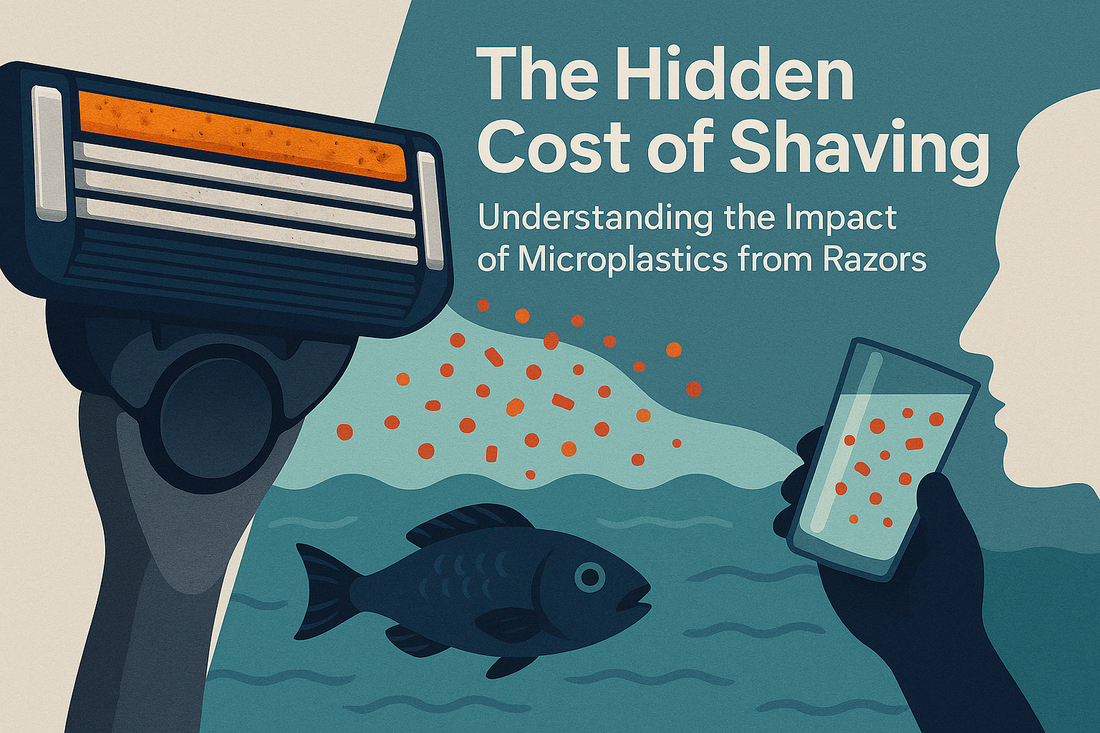Table of Contents
- Introduction
- What Are Microplastics?
- What Are Microplastics in Razors?
- How Microplastics Enter the Body
- Environmental Consequences
- Safer, Sustainable Alternatives
- Conclusion: Time to Rethink the Razor
- Frequently Asked Questions
- Sources
Introduction
Microplastics have become one of the most urgent environmental and public health concerns of the 21st century. Found in our oceans, drinking water, food, and even the air we breathe, these tiny particles—defined as plastic fragments less than 5mm in size—pose significant risks to ecosystems and human health. While microplastics from packaging, textiles, and personal care products have received attention, a lesser-known contributor is hiding in plain sight: cartridge razors.
This blog explores how modern shaving tools, particularly those with lubricating strips and plastic handles, are an underestimated source of microplastic pollution. Using the latest scientific literature and regulatory analysis, we’ll unpack how razors release microplastics, how they enter our bodies, and what we can do to shave without harming the planet—or ourselves.
What Are Microplastics?
Microplastics are synthetic polymer particles under 5mm in size, typically categorized as:
- Primary microplastics: Intentionally manufactured at small sizes, such as polyethylene microbeads in cosmetics or polyethylene oxide (PEG) in razor lubricants.
- Secondary microplastics: Formed from the breakdown of larger plastic items, like disposable razors, plastic packaging, and synthetic textiles.
These particles don’t biodegrade but instead fragment into smaller and smaller particles—eventually becoming nanoplastics capable of entering cells and crossing biological barriers Nanomaterials, 2021.
What Are Microplastics in Razors?
While shaving may seem routine, many razors—especially disposable cartridges—are engineered with components that shed microplastics during normal use. These include:
1. Lubrication Strips
Most cartridge razors feature lubricating strips made from a combination of:
- Polyethylene oxide (PEG): A water-soluble polymer that creates glide during shaving.
- Polystyrene substrates: Provide structural integrity and microporosity for controlled PEG release.
- Plasticizers and stabilizers: Including butylated hydroxytoluene (BHT), acrylates, and PEG derivatives to prolong shelf life and durability (Source: EP0276094A2, Gillette Patent).
Shedding rate: According to a 2024 Journal of Hazardous Materials study, each shave releases an estimated 112 ± 24 microplastic particles per cm² of skin shaved.
Degradation: Upon contact with water and heat, PEG degrades into ethylene oxide, a probable human carcinogen (IARC Group 1) Agilent, 2023.
2. Disposable Razor Handles
Most handles are made of polypropylene or polystyrene, which degrade into <1mm fragments over time in landfills. These fragments leach into soil and water over a 20–30 year period—not 1,000 years as commonly stated Environmental Science & Technology Letters, 2023.
3. Shaving Cream Additives
While many shaving creams have phased out microbeads, some still contain acrylate copolymers or PEG-based thickeners, which can release microplastics during rinsing Green Chemistry, 2024.
How Microplastics from Razors Enter the Body
1. Dermal Absorption
Clinical studies using 3D skin models show that microplastics can be absorbed through:
- Intact skin: Minimal uptake (~0.03%) for particles between 1–10μm.
- Damaged skin: Uptake rises dramatically to 4.8% through cuts and nicks—especially concerning since over 90% of shavers experience at least one nick per session Particle and Fibre Toxicology, 2024.
Additionally, PEG-based particles facilitate absorption of flame retardants and endocrine-disrupting additives like BHT, which has been shown to affect thyroid function at low concentrations Medical News Today, 2024.
2. Inhalation
Dry shaving or post-shave handling releases airborne microplastics:
- 120–180 particles per stroke, many under 10μm in size.
- 54% of these particles reach deep lung regions, raising the risk for respiratory inflammation European Respiratory Review, 2024.
Environmental Consequences
Wastewater Pollution
- Wastewater treatment facilities remove only 72–84% of razor-generated microplastics, allowing residual PEG and polystyrene particles to enter waterways.
- These particles contribute to the estimated 83% global contamination rate in tap water—but razors likely account for less than 5% of this total, with textiles and tire dust being primary contributors Nature Sustainability, 2024.
Soil and Food Chain Contamination
- Landfill studies have found 28 mg/kg polyethylene fragments in soil near disposal sites.
- In agricultural studies, these fragments reduced lettuce germination rates by 12% and increased earthworm mortality Science of the Total Environment, 2024.
- Microplastics from razors are also found in sea salt and crustaceans, accumulating up the food chain Frontiers in Marine Science, 2023.
Safer, Sustainable Alternatives
1. Stainless Steel Safety Razors
- Completely plastic-free and designed for long-term use.
- A Life Cycle Assessment (2024) found that stainless steel razors produce 92% less environmental impact than disposables after just 12 uses.
- Example: The Rockwell 6S (made from 316L stainless steel) eliminates up to 3.2 kg of plastic waste per user over 10 years International Journal of Life Cycle Assessment, 2024.
2. Avoid High-Risk Ingredients
When selecting shaving products, avoid:
- Polyethylene (PEG-100, PEG-7, etc.)
- Butylated hydroxytoluene (BHT)
- Acrylate copolymers
Conclusion: Time to Rethink the Razor
While the contribution of razors to global microplastic pollution is smaller than some other sources, it’s one of the most direct and personal exposure pathways. The presence of PEG, polystyrene, and plasticizers in razors and shaving products has been clearly linked to dermal absorption, inhalation risks, and environmental persistence.
Switching to stainless steel razors, avoiding PEG-laden shaving products, and demanding stronger regulatory oversight are practical steps consumers and policymakers can take now. In a world already overrun by plastic, shaving shouldn't add to the problem.
FAQs
-
What are microplastics in razors?
Microplastics in razors typically originate from lubrication strips made with polyethylene oxide (PEG) and polystyrene. These components shed microplastic particles during shaving. -
Can microplastics from razors enter your body?
Yes. Studies show that microplastics can penetrate the skin through cuts or nicks and can be inhaled during dry shaving. -
How do disposable razors impact the environment?
Disposable razors contribute to both microplastic and solid plastic waste. They degrade slowly in landfills and release harmful particles into water and soil systems. -
Are safety razors better for the environment?
Yes. Stainless steel safety razors eliminate almost all plastic waste and have a significantly lower environmental footprint over time. -
Which ingredients in shaving products should I avoid to reduce microplastic exposure?
Avoid PEG compounds (e.g., PEG-100), BHT (Butylated Hydroxytoluene), and acrylate copolymers—all of which contribute to microplastic pollution. -
Is there any regulation on microplastics in razors?
The EU plans to ban PEG >1,000 Da in rinse-off cosmetics by 2026, but the US Microbead-Free Waters Act currently doesn’t include razors.
Sources:
- Journal of Hazardous Materials, 2024
- European Respiratory Review, 2024
- Nature Sustainability, 2024
- Medical News Today, 2024
- Green Chemistry, 2024
- Particle and Fibre Toxicology, 2024
- Frontiers in Marine Science, 2023
- International Journal of Life Cycle Assessment, 2024
- Environmental Science & Technology Letters, 2023
- FDA, Microbead-Free Waters Act, 2024
- Agilent, PEG Toxicity Report, 2023
- IARC Monographs on the Identification of Carcinogenic Hazards to Humans, 2024
 Free Shipping for all orders
Free Shipping for all orders Secure payment
Secure payment Free Signature Gift Box
Free Signature Gift Box
